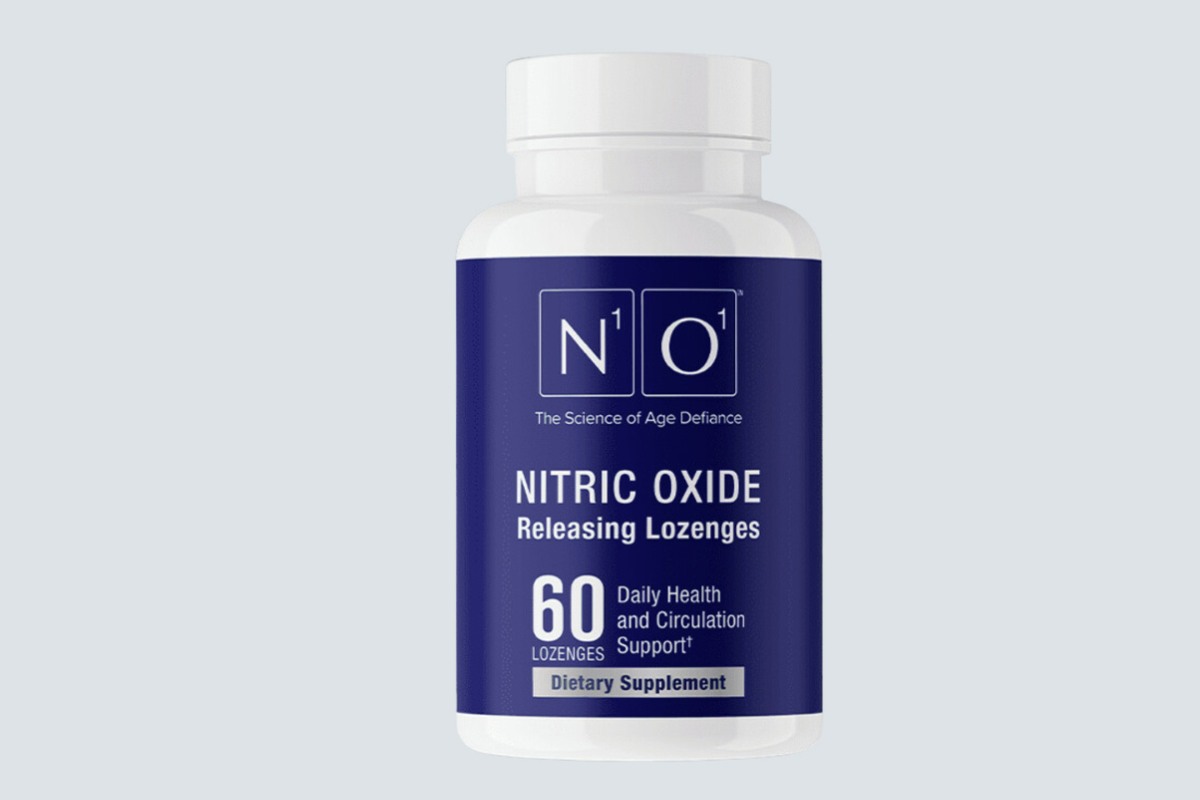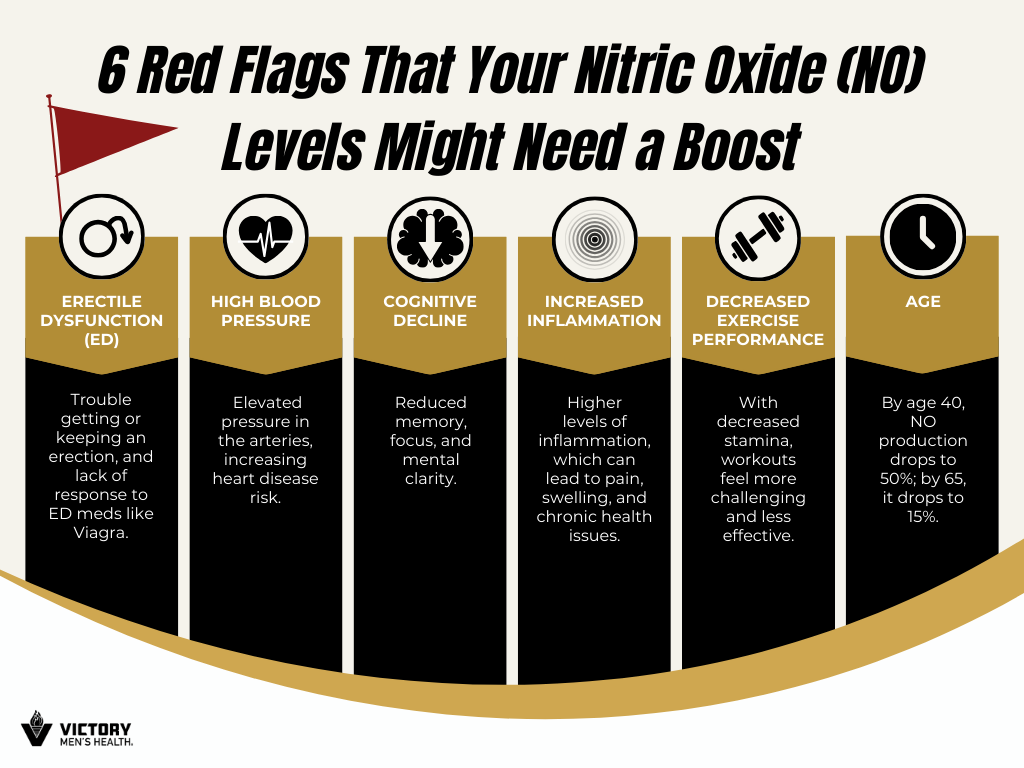6 Symptoms of Low Nitric Oxide | Symptoms To Watch For
category: ED

Let’s talk about a tiny molecule that packs a major punch in men’s health—Nitric Oxide (NO). Nitric Oxide is like the superhero of your bloodstream, helping to keep things flowing smoothly, from your muscles to your manhood.
But what happens when your NO levels start to dip? Well, that’s where things can get a little rocky. In this article, our men’s health experts are diving deep into the world of nitric oxide and exploring five symptoms that could be signaling low levels of this essential molecule.
What is Nitric Oxide?
Think of nitric oxide as the traffic cop of your blood vessels, directing blood and oxygen flow to where it’s needed most. It’s responsible for keeping your arteries nice and relaxed, ensuring blood can pass through without hiccups.
But NO isn’t just about blood flow; it’s also a key player in reducing inflammation and supporting nerve function. In other words, it’s an essential part of your overall health and well-being.
In simpler terms, it helps your blood vessels relax and expand, allowing better blood flow and oxygen delivery throughout your body.
How do I know if I have low nitric oxide levels?
Wondering if your body’s nitric oxide levels are running on empty? By working closely with your healthcare provider, you can gain a better understanding of your NO status and take steps to optimize your nitric oxide levels for improved health and vitality.
In our recent podcast episode with Dr. Nathan Bryan, we discussed some of the methods you should use to determine whether your levels are low:
You might think about using test strips to check your nitric oxide levels at home. However, Dr. Bryan advises against it due to their inaccuracy.
“I don’t use those test strips anymore because of the false positives. They can create confusion and give a false sense of security,” he says. Instead, paying attention to your symptoms and overall health is a more reliable way to assess your nitric oxide levels.
How to Test Nitric Oxide Levels:
- Nitric Oxide Testing Strips
- Max Pulse Device
- Comprehensive Blood Tests
Why shouldn’t I use nitric oxide test strips?
Take it from the expert – testing nitric oxide levels with test strips might seem convenient, but they’re not the best choice due to their potential inaccuracies. Dr. Nathan Bryan points out that these strips often give false positives, creating confusion and a false sense of security. For instance, someone might show optimal levels on a strip despite having clear symptoms of nitric oxide deficiency, like high blood pressure or erectile dysfunction.
This discrepancy can lead to misdiagnosis and improper treatment. As Dr. Bryan says, “I don’t use those test strips anymore because of the false positives.” Instead, he recommends focusing on symptoms and overall health assessments to get a more accurate picture of your nitric oxide levels.
Comprehensive blood tests are best.
When in doubt, a comprehensive blood test can shed light on your nitric oxide levels and other important markers of cardiovascular health. By analyzing factors like endothelial function, inflammation, and oxidative stress, healthcare providers can paint a clearer picture of your overall NO status and identify any potential issues.
This is the only way to truly understand your NO levels and how they affect your overall health, so we always recommend seeking comprehensive lab work. With our new cardiovascular testing service, we use a lab panel through Boston Heart Labs which has markers related to nitric oxide to give you a better idea of where you’re at.
And of course, your lifestyle habits matter.
Everyone is looking to optimize their health, but it’s harder in practice when it requires lifestyle changes like exercise, quitting smoking, and changing your diet. But these factors can all impact your nitric oxide production, so your lifestyle habits can offer valuable insights into where your NO levels are at.
By taking a good look at your lifestyle and medical background, healthcare providers can identify potential risk factors for low NO levels and tailor their approach accordingly.
6 Symptoms of Low Nitric Oxide

Here are five red flags that could indicate your NO levels need a boost:
- Erectile Dysfunction (ED)
- High blood pressure
- Cognitive decline
- Increased inflammation
- Poor exercise performance
- Age
Erectile Dysfunction (ED)
If you’ve been having trouble in the bedroom, low nitric oxide levels could be part of the problem. NO plays a crucial role in the process of getting and maintaining an erection. It helps to relax the blood vessels in your penis, allowing blood to flow in and create that magic moment.
When your nitric oxide levels are low, the pipes can get a little clogged, making it difficult for you to rise to the occasion.
High Blood Pressure
Your heart is the engine that keeps your body running, so it’s essential to keep it in top shape. But if you have low nitric oxide levels, your cardiovascular health could be at risk. NO helps to keep your blood vessels relaxed and flexible, preventing them from becoming stiff and narrow.
When NO levels drop, your arteries can’t expand as they should, leading to high blood pressure, plaque buildup, and an increased risk of heart disease. Think of it like trying to force water through a clogged pipe.
Cognitive Decline
Your brain is your body’s command center, responsible for everything from learning and memory to decision-making and problem-solving. But if your NO levels are low, your cognitive function could take a hit.
Nitric oxide helps to regulate blood flow to your brain, ensuring that it gets the oxygen and nutrients it needs to function optimally. A drop in your NO levels can inhibit your brain’s ability to work as efficiently, leading to brain fog, memory problems, and difficulty concentrating.
Increased Inflammation
If you’ve been dealing with increased inflammation, it might be a sign that your nitric oxide levels could use a boost. Nitric oxide is essential for healthy blood flow and immune function, both of which help your body manage inflammation.
When your levels are low, you may notice more joint discomfort, sluggish recovery after workouts, or even a general sense of fatigue. By supporting your nitric oxide levels, you could see improvements in how your body handles inflammation, ultimately feeling more energetic and resilient.
Poor Exercise Performance
You used to breeze through your workouts, but lately, you’ve been struggling to keep up. Your muscles feel tired and sluggish, and no matter how hard you push, you just can’t seem to hit your stride. Sound familiar? Low nitric oxide levels could be to blame.
Without enough nitric oxide to keep your blood flowing smoothly, your muscles aren’t getting the oxygen and nutrients they need to perform at their best. It’s like trying to drive a car with a clogged fuel line—not exactly a recipe for success.
Age
As we age, our nitric oxide (NO) production takes a significant dip—by age 40, it’s down to about 50%, and by 65, it’s dropped to just 15%. This decline can impact everything from blood flow and energy to recovery and overall vitality.
If you’re noticing slower recovery times, lower stamina, or more frequent aches and pains, age-related NO decline could be a key factor. Supporting your nitric oxide levels as you age can help keep your body feeling energized, improve circulation, and enhance your quality of life.
What do I do for low nitric oxide levels?
Low nitric oxide levels can wreak havoc on your body and your quality of life, but there are steps you can take to boost your NO levels. From incorporating nitric oxide supplements into your routine to making lifestyle changes that support nitric oxide production, there are plenty of ways to give your body the support it needs.
So, if you’ve been experiencing any of these symptoms, don’t ignore them—listen to what your body is telling you and take action. Our team at Victory Men’s Health is here for you. If you’re experiencing a reduction in your NO levels, we’ll work with you to create a customized treatment plan that’s right for you.
How and When to Take Nitric Oxide Supplements
When it comes to selecting a nitric oxide supplement, it’s crucial to choose one that is effective and backed by solid scientific research. Dr. Nathan Bryan, a pioneer in nitric oxide research, offers two standout products: N101 lozenges and NOBeetz. Here’s what makes them a top choice:
N101 Lozenges
- Direct Nitric Oxide Generation: Unlike many supplements that rely on the body to convert precursors into nitric oxide, N101 lozenges directly generate nitric oxide. This ensures consistent and reliable delivery.
- Essential Cofactors: The lozenges include magnesium and vitamin C, which are essential for optimal nitric oxide production. As Dr. Bryan explains, “75% of Americans are deficient in magnesium, which is crucial for nitric oxide production.”
- Great Taste and Compliance: The lozenges are designed to taste good, which improves compliance. “The beauty of the lozenge is number one, it tastes good. And number two, it releases a lot of nitric oxide over five to six minutes as it dissolves,” says Dr. Bryan.
NOBeetz
- Enhanced Formula: NOBeetz combines fermented beets, which are optimized to maximize nitric oxide activity, with electrolytes and a patented ATP (adenosine triphosphate) ingredient to boost cellular energy.
- Oxalate-Free: Traditional beet products can be high in oxalates, which may cause kidney stones. NOBeetz removes these oxalates, making it safer and more effective.
- Convenient and Potent: Packaged in individual sachets, NOBeetz ensures precise dosing and immediate nitric oxide production when mixed with water. “We designed it as a shot to ensure the nitric oxide is released inside your body, not in a glass cup,” Dr. Bryan advises.
Many products on the market, such as those containing arginine or citrulline, are less effective because they rely on the body’s ability to convert these amino acids into nitric oxide, which often doesn’t happen efficiently. As Dr. Bryan puts it, “Nitric oxide deficiency is never caused by an arginine deficiency.”
When to Take Nitric Oxide Supplements
Timing is crucial when it comes to maximizing the benefits of your nitric oxide supplement. Here are some key times to consider:
- Before Exercise – Taking your nitric oxide supplement about 30 minutes to an hour before a workout can help enhance blood flow to your muscles, improving your exercise performance and endurance. This pre-workout boost can make your workouts more effective and enjoyable.
- Before Bed – Some studies suggest that taking nitric oxide supplements before bed can support overnight recovery and cardiovascular health. Improved blood flow during sleep can help your body repair and rejuvenate, leading to better overall health.
- In the Morning – Starting your day with a nitric oxide supplement can help improve blood flow and oxygen delivery in your body, setting the stage for better energy levels and cognitive function throughout the day. This can be especially beneficial if you often feel sluggish or fatigued in the mornings. “The first thing you do in the morning is take the nitric oxide lozenge,” says Dr. Bryan. It helps prevent heart attacks, which are more likely to occur before 10 a.m.
Take Action With Victory Men’s Health
Ready to boost your nitric oxide levels and reclaim your vitality? At Victory Men’s Health, we offer high-quality nitric oxide supplements and personalized health assessments to help you tackle symptoms of low nitric oxide. Our team is dedicated to educating you on the benefits and proper usage of these supplements to ensure you achieve the best possible health outcomes.
Contact us today to begin your journey toward improved health and vitality.